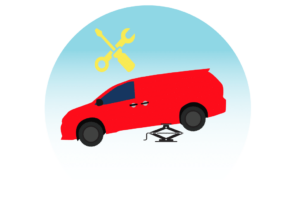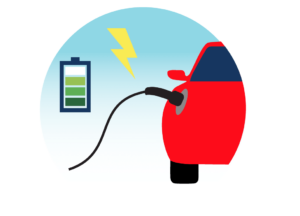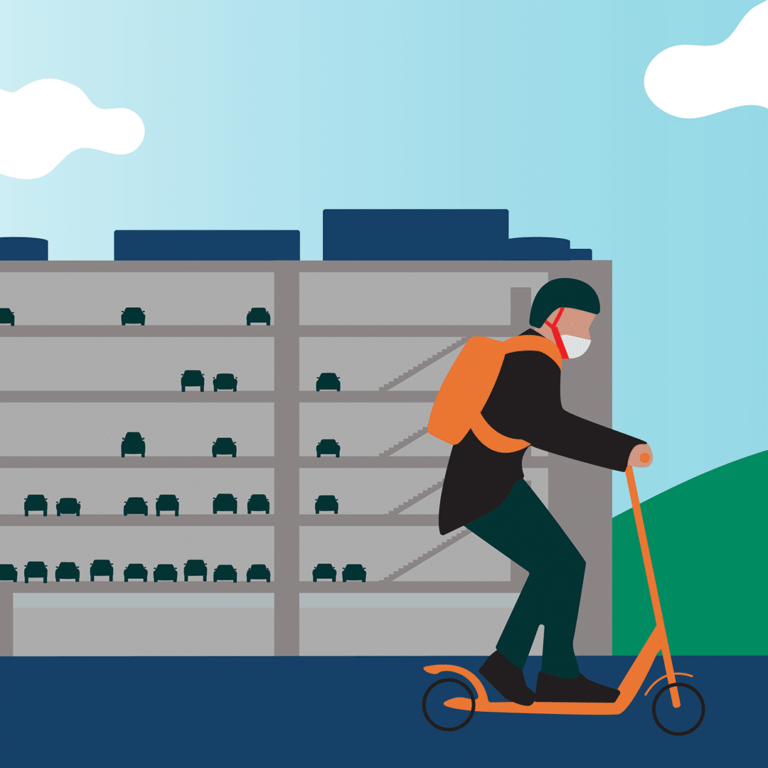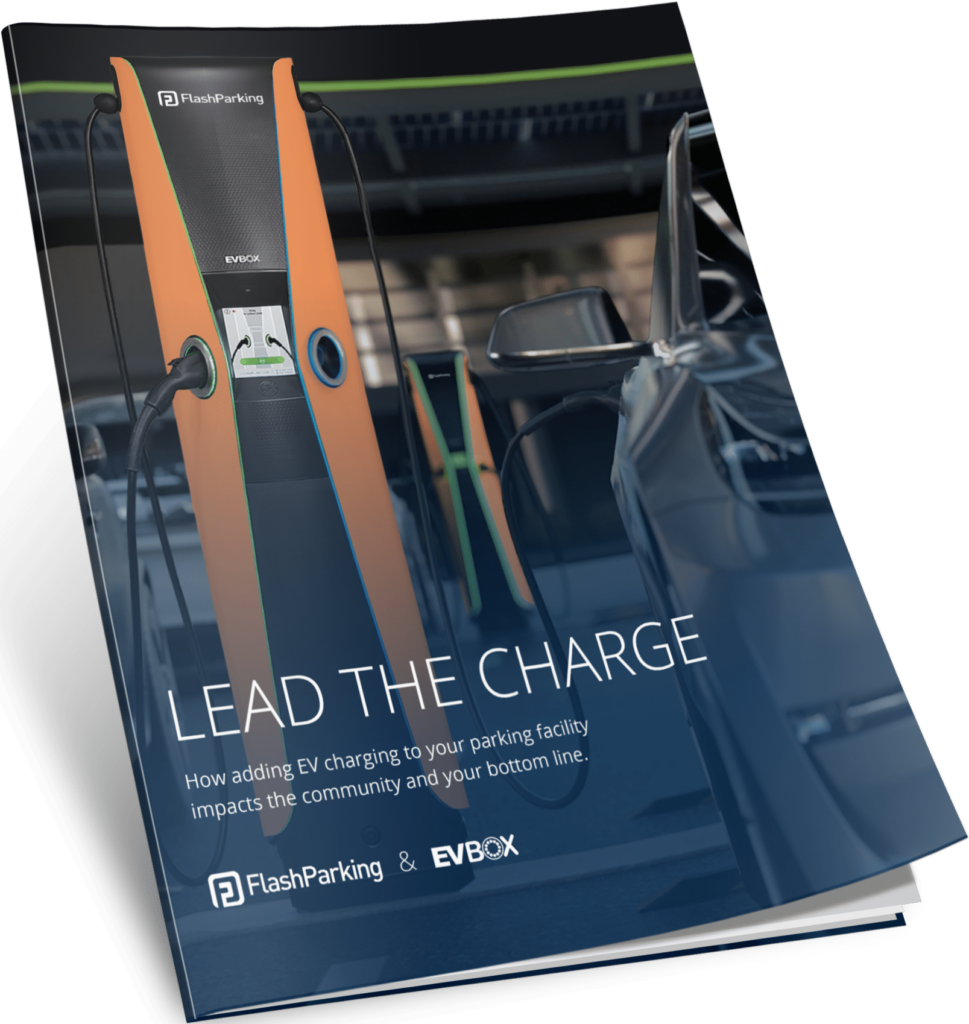The secret about flexible work is out. The beans are spilled. The cat is out of the bag and sleeping at the foot of your bed. Spoiler: Remote and flexible work plans are proving to be a boon for businesses. In fact, despite workplace challenges spurred by a global pandemic, multiple studies show that flexible work plans boost productivity and morale in the workforce.
It is perfectly natural for any commercial property owner or manager to see a problem with this newfound way of working. An empty parking lot is an underutilized space, and underutilized assets cost money.
But flexible work doesn’t spell the end of the need for space, parking or otherwise. People are still moving around, getting out when they can, and driving from A to B. What’s changed is why drivers choose to get behind the wheel. More than ever, parking facility managers need to understand driver and employee motivation; then adapt their spaces to provide solutions for customers that will help sustain their business through the pandemic. As the saying goes: in crisis, there is an opportunity.
What Is Flexible Work?
More than just working from home (WFH), a flexible work schedule surpasses the conveniences of the usual 9-5 telecommute. A flex work week offers employees the ability to get work done according to their own schedules and on their own terms.
Employees need flexibility because the age of COVID has brought on some diverse and less-than-optimal circumstances. In one study, 62% of employees indicated that they can work remotely, but 28% of those same workers still need to go into their office at least once per week. Another 52% of respondents in another survey reported that they lack the bandwidth to work from home effectively. Meanwhile, 93% of households with children need to support distance learning during hours when adults would typically be at their desks.
Office workers who take advantage of flex work weeks have the desire and motivation to be productive, but they still face challenges in delivering great work for their employers. Those challenges have consistent themes: the need for safety, bandwidth, privacy, and the ability to manage their time. Parking assets can provide the answers.
Underutilized parking spaces can be a benefit for the flexible work week. Let’s look at five ways commercial parking facilities can help employees and their businesses.
1: Expand your workspace footprint, inside and out.
From a safety standpoint, the need for social distancing spells the end of the open office plan—an interior design concept responsible for ever-shrinking personal office space since the 1960s. Love them or hate them (there are some strong feelings on the subject), studies declared open office plans detrimental to your health long before 2020.
To expand interior space, companies that suddenly have a large number of remote workers can reclaim the now-unused workspace. They can then redistribute that space to those employees who absolutely must be in the office. Fewer desks in the same space not only allows for social distancing, it also introduces options like shared desks between two employees with staggered schedules or a return to hot desking.
For expanding out into unused parking space, businesses should take a critical look at all the things that take up space inside and evaluate their worth. Think of this as a sort of Marie Kondo for office management, and ask yourself if those rows and rows of file cabinets are bringing you joy (or revenue). Could all the cardboard boxes and supplies you’re saving be relocated into new storage spaces located in your parking facility?
The next level of footprint expansion involves moving people outside. Many remote workers are already seeking out fresh air and space on their own. Why not the same for commercial offices? The potential uses for open space ranges. It can play out as anything from moving the company cafeteria to the parking garage rooftop to recycling shipping containers into hip freestanding offices.

2: Consider convenient amenities you can add to your parking structure.
Beyond providing parking, look at the other essential services you can provide to employees that make their lives easier.
Every office worker needs laundry and dry cleaning. Services such as Laundry Locker are easily installed, and allow anyone to drop off and pick up cleaning at their convenience. Similarly, major shipping providers like FedEx and UPS offer access points or lockers that provide consumers secure means to drop off or pick up packages for shipping.
Another holistic way to consider the amenities you can bring to your garage is to look at the local businesses that are closest to your facility—businesses that may also be struggling due to the flexible work week. Try reaching out to a nearby grocery store that is willing to be a partner for delivering groceries to employees at the end of the day. Get in touch with local restaurants that can have family dinners neatly packed up and ready to be picked up on the way out of the office.
By centralizing all these essential services, employees can make fewer stops on their commutes to and from work. Fewer stops means lowering their risk of exposure while they gain back time to spend with their families. Parking management leaders who offer amenities like these boost morale among employees, while demonstrating real commitments to their community’s businesses.
3: Become a hub for micro-mobility.
According to recent mobility trends, the only destinations more negatively impacted by COVID than workplaces are public transit hubs. To avoid risking exposure to sickness, people are choosing their cars over public transportation.
While public transit is waning, some on-street parking is disappearing entirely. A popular trend rapidly accelerated by the pandemic is the reclamation of street space. Communities need space to gather. Kids need places to play. Everyone wants to feel safe on their block. Parked cars and busy roads don’t contribute to those desires.
Cities are answering residents’ demands by creating car-free zones while banning traffic and parked cars from local neighborhoods. In addition, major cities are lending a hand to struggling restaurants by permitting them to create outdoor dining in the parking space in front of their property.
People are driving more while there are fewer places to park. This is an opportunity for any urban parking facility manager.
It’s natural for drivers to desire to find parking as close to their destination as possible. When that’s no longer an option, those same drivers will seek to park where they can easily transition to a last-mile solution. Partnering with micro-mobility providers like shared bike docks and rentable eScooters gives parkers their answer to traveling that last mile.
Through a micro-mobility partnership, commercial lots can attract workers from miles around, allowing them to park easily, then use shared mobility to safely get to their offices. Plus, it attracts a new generation of connected, app-savvy drivers while converting your underutilized space into a new revenue stream.

4: Convert your commercial parking into a place of commerce.
In the absence of cars, how else can you profit from your parking asset? Look at supply and demand.
Flexible work week employees demand bandwidth, privacy, and access. Before COVID, shared workspaces like WeWork were already answering those needs and prompting other businesses with unused space to jump on the flexible workspace wagon. This concept is easily applied to the open space available in a parking garage. For a fantastic example, you need not look further than The Garage at Northwestern, a collaborative office, “makerspace,” shared workroom, and café carved out of one of the campus parking structures.
Another demand in short supply: entertainment. Most movie theaters and concert venues across the U.S. are shut, and the summer blockbuster season is put off indefinitely. In response, local malls are converting their parking lots into drive-in theaters and inviting local food trucks and restaurant pop-ups to cater. This model can be adapted to almost any outdoor space, and it’s good inspiration for creating event-oriented revenue for your asset.
Consumer goods are on the table too. Farmer’s markets have been declared essential businesses in a dozen states, and their ability to operate in the open air makes them ideal for shopping while lowering risks for exposure. However, those markets struggle to find spaces large enough to set up where they can serve as large a community as possible. A large-scale parking lot is the perfect answer.
5: Make it easy for anyone to access.
Ensuring that employees, guest parkers, and new customers can all come and go with zero friction is the foundation for any strategy for repurposing your commercial parking space.
Suppose you take on the challenge of turning your parking asset into a dynamic, multi-purpose, community-focused space. Your systems have to be ready to handle all the contingencies involved. Systems like FlashOS make managing the hard parts easy by allowing managers to remotely control dynamic pricing—like adding the cost of a movie ticket on Friday night.
Likewise, license plate recognition (LPR) technology like FlashVision can track all vehicles that enter your property, discern between employees and visitors, and charge appropriately as each car exits.
These suggestions are just a sampling of how property owners can regain revenue from unused parking assets. Without question, there are more options yet to be invented that serve your business while also serving your employees and your community. We can help you discover them.
Join the Parking Revolution, Subscribe
to Our Newsletter
We’re disrupting the parking industry because we believe our customers, consumers, and cities deserve better.


